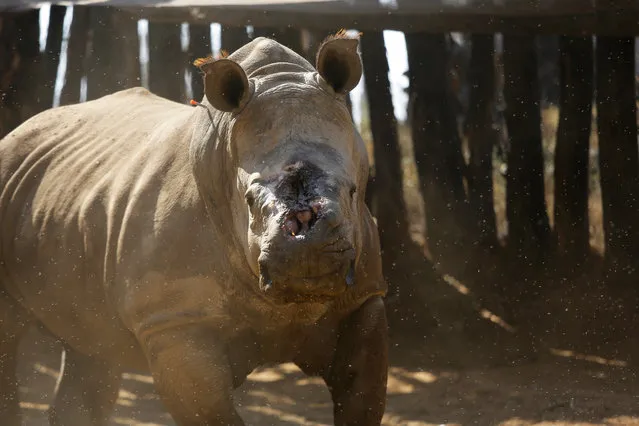
The eight-years-old White Rhino Seha (short for Sehawukele meaning “have mercy on us” in Zulu) is seen with the open wound left behind by poachers after they hacked off both his horns during the poaching rapage on a private reserve in the North West Province in Johannesburg, South Africa, 28 July 2017. Seha is the only survivor after five rhinos where poached on the same game farm. South Africa has the world's largest population of Rhinos in the world. However over the past nine years a staggering 6,115 rhinos have been killed by poachers seeking their horns for sale to the lucrative traditional healing market in the Far East. In a ground-breaking and world-leading initiative, Dr Marias and Dr Glyphis from “Saving the Survivors” race to injured and poached Rhinos once they have been called by conservation groups or private rhino owners in an attempt to save the animals and heal their often horrifying open wounds. (Photo by Kim Ludbrook/EPA/EFE)
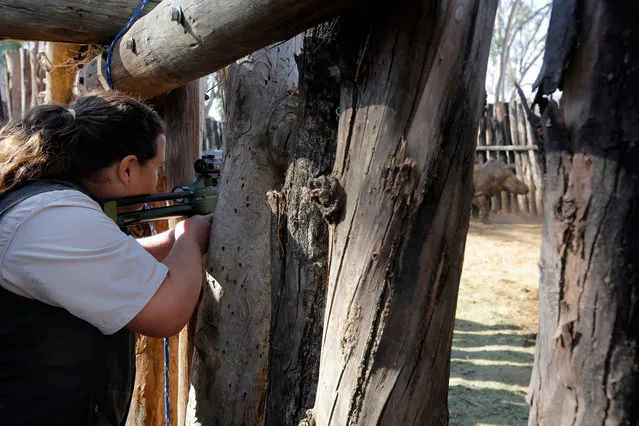
Dr Zoe Glyphis (L) shoots with a dart the eight-years-old White Rhino Seha prior his relocation to a bigger property in Johannesburg, South Africa, 28 July 2017. (Photo by Kim Ludbrook/EPA/EFE)
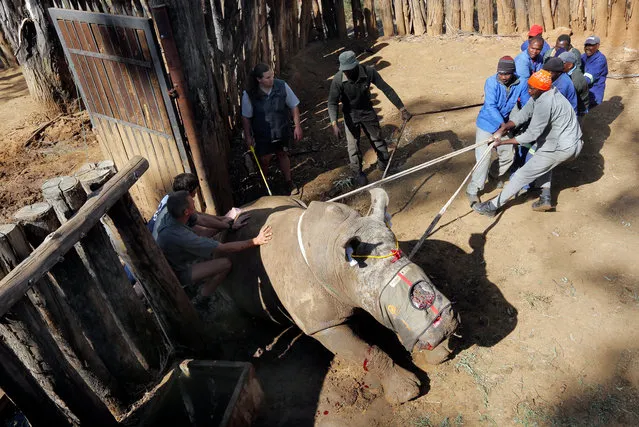
Conservation staff members move the eight-years-old White Rhino Seha into a truck as Dr Zoe Glyphis (3-L) looks on in Johannesburg, South Africa, 28 July 2017. (Photo by Kim Ludbrook/EPA/EFE)
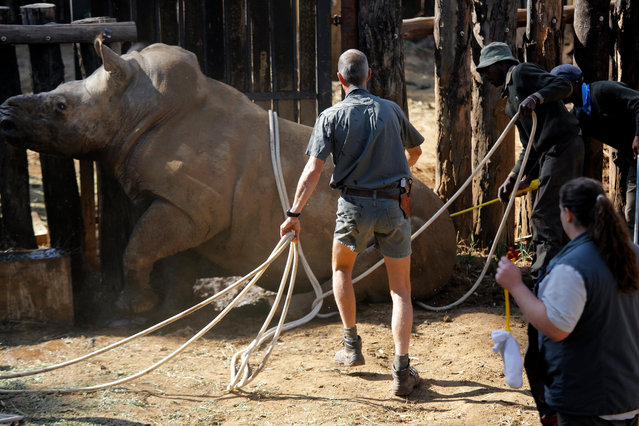
Conservation staff members move the eight-years-old White Rhino Seha into a truck in Johannesburg, South Africa, 28 July 2017. (Photo by Kim Ludbrook/EPA/EFE)
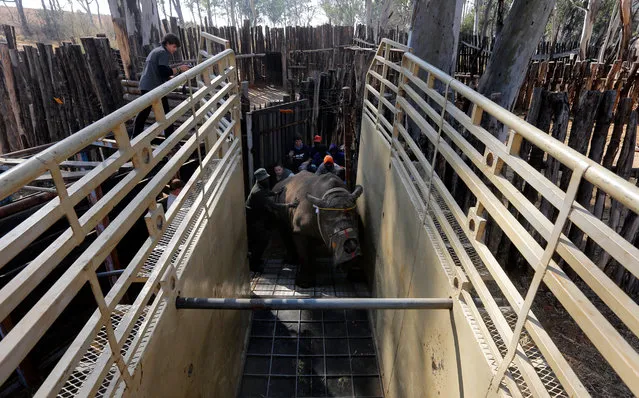
The eight-years-old White Rhino Seha is loaded into a truck by conservation staff members to move him to a better location, in Johannesburg, South Africa, 28 July 2017. (Photo by Kim Ludbrook/EPA/EFE)
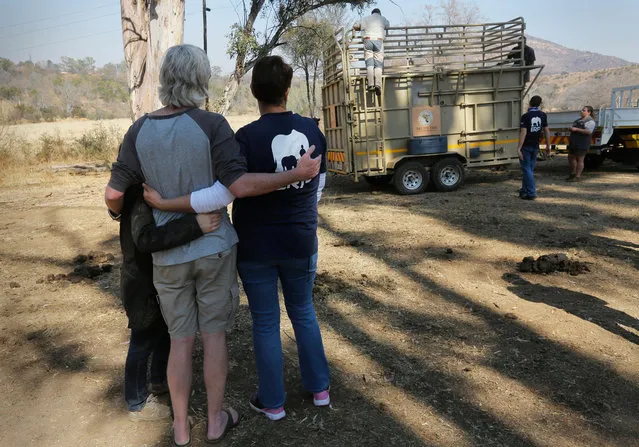
Supporters of the Elephant and Rhino People (ERP) hug each other as the eight-years-old White Rhino Seha is relocated to a better location, Johannesburg, South Africa, 28 July 2017. South Africa has the world's largest population of Rhinos in the world. However over the past nine years a staggering 6,115 rhinos have been killed by poachers seeking their horns for sale to the lucrative traditional healing market in the Far East. In a ground-breaking and world-leading initiative. (Photo by Kim Ludbrook/EPA/EFE)
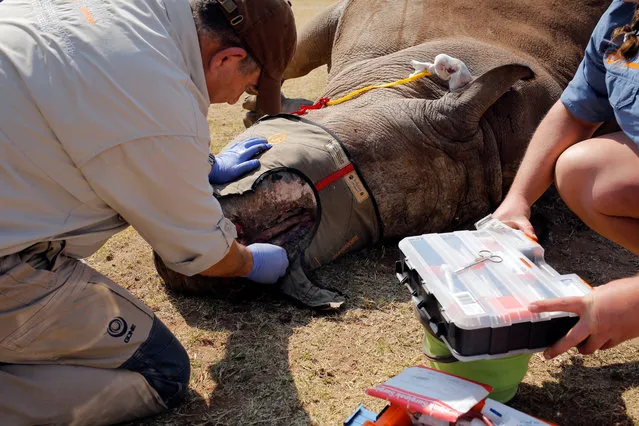
Dr Johan Marais (L) treats an open wound of the eight-years-old White Rhino Seha in Bela Bela, South Africa, 07 September 2017. (Photo by Kim Ludbrook/EPA/EFE)
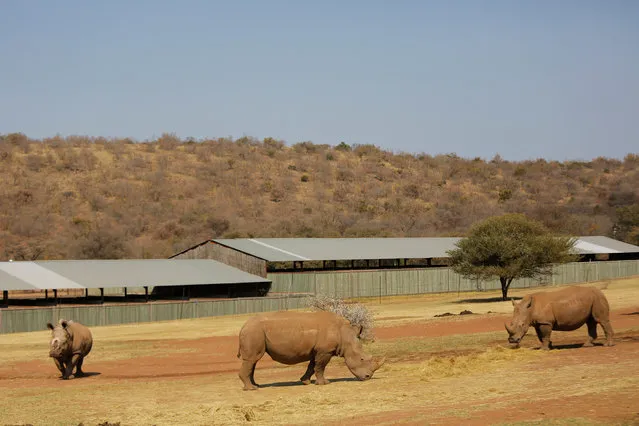
The eight-years-old White Rhino Seha (L) grazes with two white rhino females, six weeks after being relocated to this game farm from a previous boma near Johannesburg in Bela Bela, South Africa, 07 September 2017. Seha was darted by Saving the Survivors vets for further treatment to his open wound left by poachers after they hacked off his horn. (Photo by Kim Ludbrook/EPA/EFE)
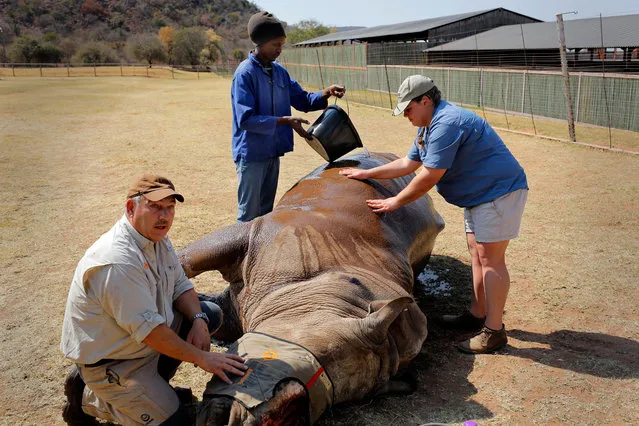
Dr Johan Marais (L) and Dr Zoe Glyphis (R) treat the eight-years-old White Rhino Seha as a game farm staff member pours water on him to keep his temperature down in Bela Bela, South Africa, 07 September 2017. (Photo by Kim Ludbrook/EPA/EFE)
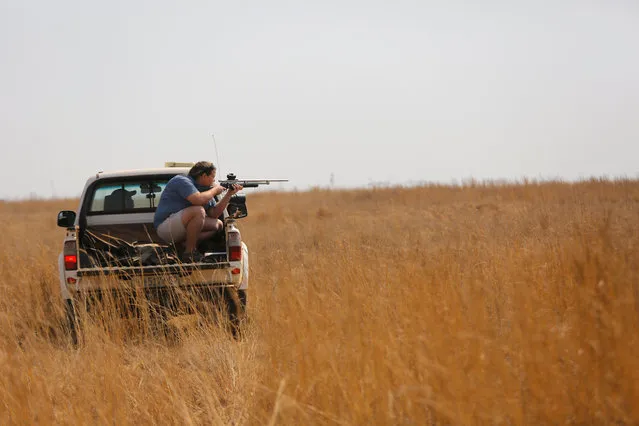
Dr Zoe Glyphis prepares to dart a cheetah at the Rietvlei Nature Reserve, Pretoria, South Africa, 07 September 2017. South Africa has the world's largest population of Rhinos in the world. However over the past nine years a staggering 6,115 rhinos have been killed by poachers seeking their horns for sale to the lucrative traditional healing market in the Far East. In a ground-breaking and world-leading initiative, Dr Marias and Dr Glyphis from “Saving the Survivors” race to injured and poached Rhinos once they have been called by conservation groups or private rhino owners in an attempt to save the animals and heal their often horrifying open wounds. Saving the Survivors (STS) vets, Dr Johan Marais and Dr Zoe Glyphis also treat other wildlife animals. (Photo by Kim Ludbrook/EPA/EFE)
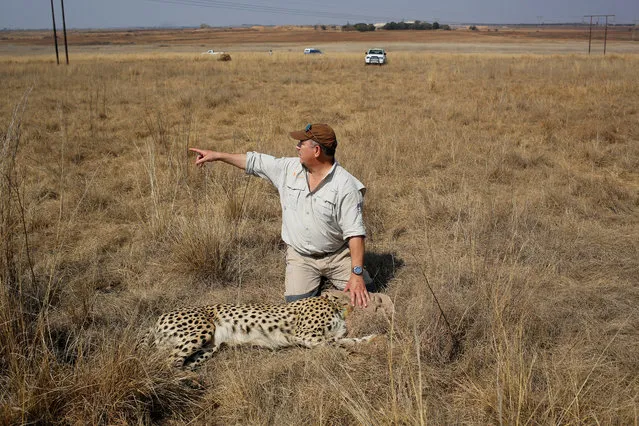
Dr Johan Marais sits with a cheetah they just darted to remove a malfunctioning collar at the Rietvlei Nature Reserve, Pretoria, South Africa, 07 September 2017. (Photo by Kim Ludbrook/EPA/EFE)
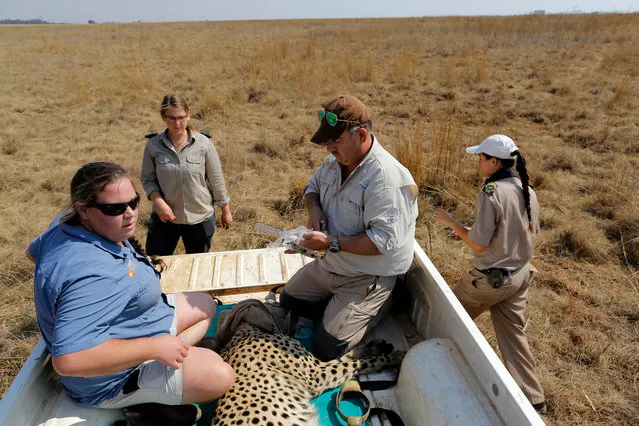
Dr Zoe Glyphis (L) and Dr Johan Marais (2-R) sit on the back of a pick-up with a cheetah they just darted to remove a malfunctioning collar at the Rietvlei Nature Reserve, Pretoria, South Africa, 07 September 2017. (Photo by Kim Ludbrook/EPA/EFE)
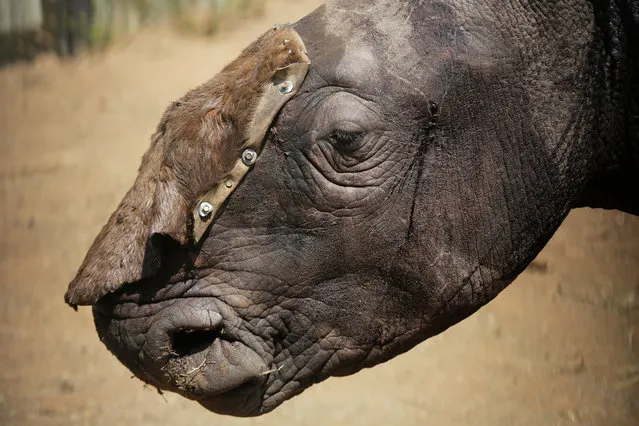
A three-years-old White male Rhino Wasinda stands alone in a boma with a temporary hid covering his open wounds prior to being treated by Saving the Survivors vets at a private game farm in the Free State Province, Clocolan, South Africa, 19 September 2017. Wasinda, Zulu for “Survivor” was poached two days earlier and had both his horns hacked off by a saw. After a closer examination it appears he was shot two times to the head by a 375 rifle with both shots traveling through his head. Most concerning for the vets was that Wasinda may have been blinded by the incident. South Africa has the world's largest population of Rhinos in the world. However over the past nine years a staggering 6,115 rhinos have been killed by poachers seeking their horns for sale to the lucrative traditional healing market in the Far East. (Photo by Kim Ludbrook/EPA/EFE)
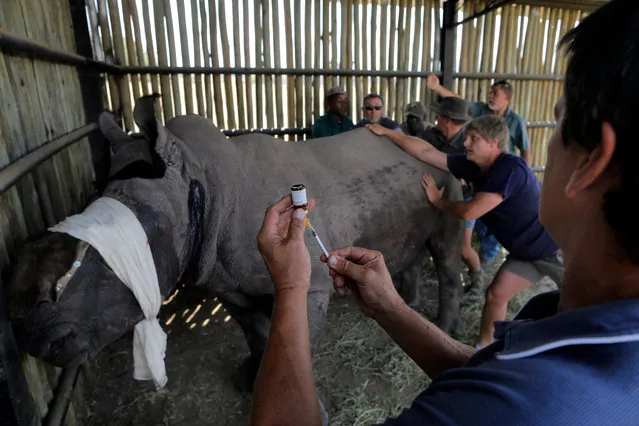
A local vet, who first treated the three-years-old White male Rhino Wasinda, prepares more drugs to tranquilize the Rhino to treat his terrible wounds left by poachers at a private game farm in the Free State Province, Clocolan, South Africa, 19 September 2017. (Photo by Kim Ludbrook/EPA/EFE)

Farm staff try to keep the three-years-old White male Rhino Wasinda in the shaded area of his boma prior to being treated for his terrible wounds left by poachers at a private game farm in the Free State Province, Clocolan, South Africa, 19 September 2017. (Photo by Kim Ludbrook/EPA/EFE)
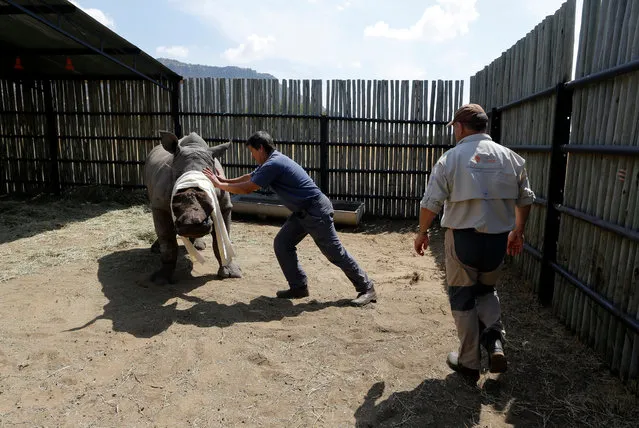
Dr Johan Marais (R) and a local vet, who first treated the three-years-old White male Rhino Wasinda, move the Rhino into the boma to treat his terrible wounds left by poachers at a private game farm in the Free State Province, Clocolan, South Africa, 19 September 2017. (Photo by Kim Ludbrook/EPA/EFE)
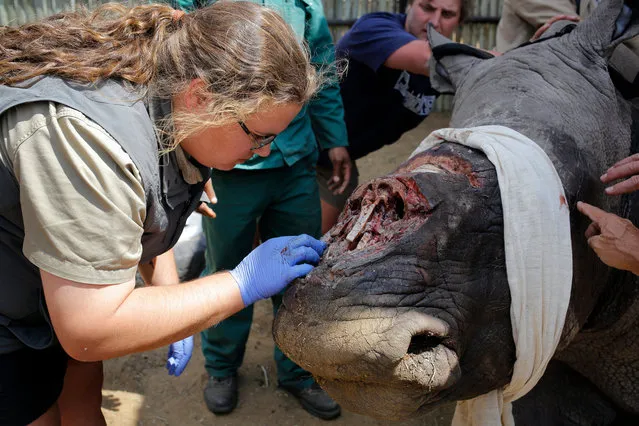
Dr Zoe Glyphis (L) treats the open wounds on the nose area of the three-years-old White male Rhino Wasinda, after he had his horns hacked off by poachers at a private game farm in the Free State Province, Clocolan, South Africa, 19 September 2017. (Photo by Kim Ludbrook/EPA/EFE)
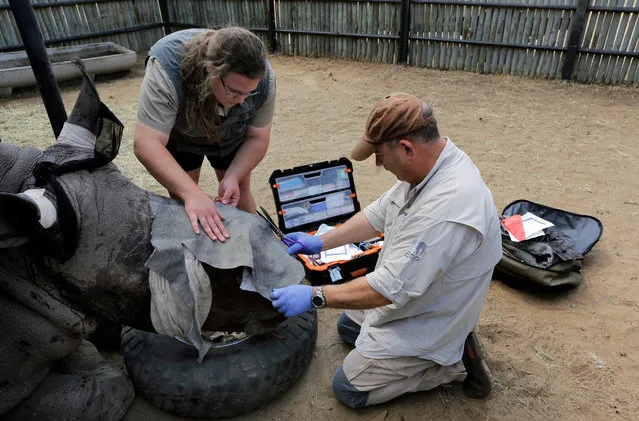
Dr Zoe Glyphis (L) and Dr Johan Marais (R) prepare a piece of elephant hide to cover the open wounds on the nose area of the three-years-old White male Rhino Wasinda, after he had his horns hacked off by poachers at a private game farm in the Free State Province, Clocolan, South Africa, 19 September 2017. (Photo by Kim Ludbrook/EPA/EFE)
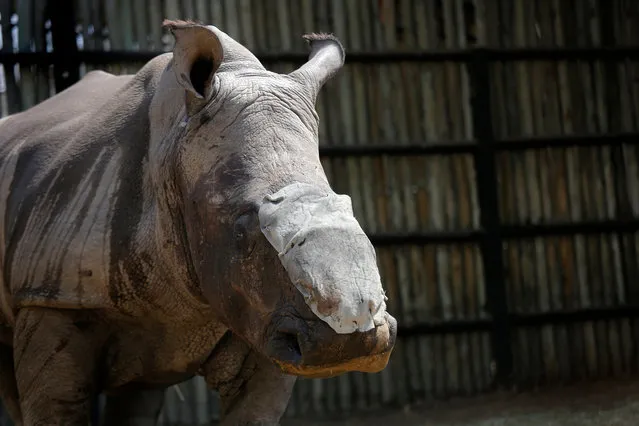
A three-years-old White male Rhino Wasinda, recovers after his open wound was cleaned and a piece of elephant hide was attached to cover the wound at a private game farm in the Free State Province, Clocolan, South Africa, 19 September 2017. (Photo by Kim Ludbrook/EPA/EFE)
06 Oct 2017 06:36:00,
post received
0 comments
